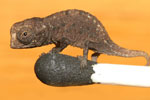
A new species of owl: Rinjani scops owl. Photo by: Philippe Verbelen.
Want to find a new species of owl? Just listen. A unique whistling call has led scientists to discover a new owl on the Indonesian island of Lombok, according to a new study in PLoS ONE. Two scientific expeditions, occurring separately but within a few days of each other, both noticed something different about the calls coming from owls on Lombok.
“It was quite a coincidence that two of us identified this new bird species on different parts of the same island, within a few days of being on the island,” George Sangster with the Swedish Museum of Natural Historyn said, adding, “especially considering that no-one had noticed anything special about these owls in the previous 100 years.”
The owl on Lombok was long-thought to be a population of the Moluccan scops owl (Otus magicus) due to similarities in plumage, but the unusual call pushed scientists to investigate further. Because they are nocturnal, owls depend on their calls to identify their own kind, allowing eavesdropping scientists to do the same.
“In the field, vocalizations are often the first clue that a population represents a distinct species,” the scientists write.
Owl vocalizations are not learned, and therefor “most likely [have] a genetic basis,” according to researchers. In addition, owls use their calls to find mates. After careful examination of museum specimens, the scientists also found morphological differences between the Lombok owl and other Indonesian owls.
“Detailed comparisons of sound recordings and museum specimens with those of other scops owls in Wallacea and the Indo-Malayan region have confirmed the distinctiveness of the Lombok population,” the researchers write.
The scientists have dubbed the new species, Rinjani scops owl (Otus jolandae), after its volcano home, Gunung (or Mountain) Rinjani. The Rinjani scops owl is found only on Lombok Island, which lies off the eastern coast of Bali. Notably, it is the island’s first endemic bird species.
“Future studies should determine the exact distribution, elevational range and population density of Otus jolandae on Lombok, and whether the species occurs throughout the lowlands where extensive forest destruction and cultivation has taken place since the type series was obtained in 1896,” the scientists write. “Very little lowland forest remains on Lombok, although Batu Gendang forest in Sekotong Tengah (southwest Lombok) still contains stretches of potentially suitable forest.”
Worldwide, there are just over 250 species of owl.
CITATION: Sangster G, King BF, Verbelen P, Trainor CR (2013) A New Owl Species of the Genus Otus (Aves: Strigidae) from Lombok, Indonesia. PLoS ONE 8(2): e53712. doi:10.1371/journal.pone.0053712
Related articles
Geneticists discover distinct lion group in squalid conditions

(02/04/2013) They languished behind bars in squalid conditions, their very survival in jeopardy. Outside, an international team of advocates strove to bring worldwide attention to their plight. With modern genetics, the experts sought to prove what they had long believed: that these individuals were special. Like other cases of individuals waiting for rescue from a life of deprivation behind bars, the fate of those held captive might be dramatically altered with the application of genetic science to answer questions of debated identity. Now recent DNA analysis has made it official: this group is special and because of their scientifically confirmed distinctiveness they will soon enjoy greater freedom.
Scientists could name every species on Earth in 50 years

(01/28/2013) A bold new paper in Science argues that the world’s species could be named and described before they vanish into extinction, though the threat of eventual extinction will remain for many, especially as climate change worsens. The scientists say that contrary to popular belief, there are more taxonomists working than ever before and there are likely less species on Earth than often reported, making finding and naming the world’s species within reach this century.
Photo: Subterranean ‘Moby Dick’ mermaid lizard discovered in Madagascar
(01/16/2013) An international team of scientists have described a bizarre new species of worm-like lizard that lives underground. Strangely, they named it the ‘Moby Dick’ mermaid skink.
Photos: Neon blue dragon discovered in Vietnamese rainforest

(01/15/2013) German and Russian biologists have discovered a stunning new species of lizard in Vietnam. The species, dubbed Calotes bachae, is described in a recent issue of the journal Zootaxa. Calotes bachae is a type of agama, a group of lizards commonly known as ‘forest dragons.’